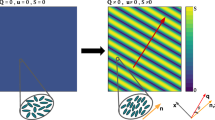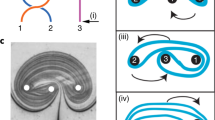Abstract
Papaseit et al. (Proc. Natl. Acad. Sci. U.S.A. 97, 8364, 2000) showed the decisive role of gravity in the formation of patterns by assemblies of microtubules in vitro. By virtue of a functional scaling, the free energy for MT systems in a gravitational field was constructed. The influence of the gravitational field on MT’s self-organization process, that can lead to the isotropic to nematic phase transition, is the focus of this paper. A coupling of a concentration gradient with orientational order characteristic of nematic ordering pattern formation is the new feature emerging in the presence of gravity. The concentration range corresponding to a phase coexistence region increases with increasing g or MT concentration. Gravity facilitates the isotropic to nematic phase transition leading to a significantly broader transition region. The phase transition represents the interplay between the growth in the isotropic phase and the precipitation into the nematic phase. We also present and discuss the numerical results obtained for local MT concentration change with the height of the vessel, order parameter and phase transition properties.
Similar content being viewed by others
References
Papaseit, C., Pochon, N., Tabony, J.: Microtubule self-organization is gravity-dependent. Proc. Natl. Acad. Sci. USA 97, 8364–8368 (2000)
de Pablo, P.J., Schaap, I.A.T., MacKintosh, F.C., Schmidt, C.F.: Deformation and collapse of microtubules on the nanometer scale. Phys. Rev. Lett. 91, 098101 (2003)
Athenstaedt, H.: Pyroelectric and piezoelectric properties of vertebrates. Ann. N.Y. Acad. Sci. 238, 68–94 (1974)
Margulis, L., To, L., Chase, D.: Microtubules in prokaryotes. Science 200, 1118–1124 (1978)
Hameroff, S.R., Watt, R.C.: Information processing in microtubules. J. Theor. Biol. 98, 549–561 (1982)
Kis, A., Kasas, S., Babic, B., Kulik, A.J., Benoît, W., Briggs, G.A.D., Schönenberger, C., Catsicas, S., Forró, L.: Nanomechanics of microtubules. Phys. Rev. Lett. 89, 248101 (2002)
Spacelab I Reports. Science 225, 205–235 (1984)
Tabony, J., Job, D.: Gravitational symmetry breaking in microtubular dissipative structures. Proc. Natl. Acad. Sci. USA 89, 6948–6952 (1992)
Portet, S., Tuszyński, J.A., Dixon, J.M., Satarić, M.V.: Models of spatial and orientational self-organization of microtubules under the influence of gravitational fields. Phys. Rev. E 68, 021903 (2003)
Melton, D.A.: Pattern formation during animal development. Science 252, 234–241 (1991)
Gerhart, J., Keller, R.: Region-specific cell activities in amphibian gastrulation. Annu. Rev. Cell. Biol. 2, 201–229 (1986)
Zisckind, N., Elinson, R.P.: Gravity and microtubules in dorsoventral polarization of the Xenopus Egg Develop. Growth Differ. 32, 575–581 (1990)
Beetschen, J.C., Gautier, J.: Heat-shock-induced grey crescent formation in axolotl eggs and oocytes: the role of gravity. Development 100, 599–609 (1987)
Malacinski, G.M., Neff, A.W.: The amphibian egg as a model system for analyzing gravity effects. Adv. Space Res. 9, 169–176 (1989)
Elinson, R.P., Rowning, B.: A transient array of parallel microtubules in frog eggs: potential tracks for a cytoplasmic rotation that specifies the dorso-ventral axis. Dev. Biol. 128, 185–197 (1988)
Driss-Ecole, D., Lefranc, A., Perbal, G.: A polarized cell: the root statocyte. Physiol. Plant. 118, 305–312 (2003)
Himmelspach, R., Wymer, C.L., Lioyd, C.W., Nick, P.: Gravity-induced reorientation of cortical microtubules observed in vivo. Plant J. 18, 449–453 (1999)
Fischer, K., Schopfer, P.: Physical strain-mediated microtubule reorientation in the epidermis of gravitropically or phototropically stimulated maize coleoptiles. Plant J. 15, 119–123 (1998)
Parsons, J.D.: Nematic ordering in a system of rods. Phys. Rev. A 19, 1225–1230 (1979)
de Gennes, P.: Polymer Liquid Crystals. Academic Press, New York, (1982)
Baulin, V.A., Khokhlov, A.R.: Nematic ordering of rigid rods in a gravitational field. Phys. Rev. E 60, 2973–2977 (1999)
Sin-Doo, L.: A numerical investigation of nematic ordering based on a simple hard-rod model. J. Chem. Phys. 87, 4972–4974 (1987)
Satarić, M.V., Tuszyński, J.A.: Relationship between the nonlinear ferroelectric and liquid crystal models for microtubules. Phys. Rev. E 67, 011901 (2003)
Tuszyński, J.A., Satarić, M.V., Portet, S., Dixon, J.M.: Gravitational symmetry breaking leads to a polar liquid crystal phase of microtubules in vitro. J. Biol. Phys. 31, 477–486 (2005)
Baulin, V.A.: Self-assembled aggregates in the gravitational field: growth and nematic order. J. Chem. Phys. 119, 2874–2885 (2003)
Stracke, R., Böhm, K.J., Wollweber, L., Tuszyński, J.A., Unger, E.: Analysis of the migration behaviour of single microtubules in electric fields. Biochem. Biophys. Res. Commun. 293, 602–609 (2002)
Bras, W., Diakun, G.P., Diaz, J.F., Maret, G., Kramer, H., Bordas, J., Medrano, F.J.: The Susceptibility of pure tubulin to high magnetic fields: a magnetic birefringence and X-ray fiber diffraction study. Biophys. J. 74, 1509–1521 (1998)
Author information
Authors and Affiliations
Corresponding author
Additional information
This article is retracted by the authors as they have carelessly (although unintentionally) copied parts of other papers.
A retraction note to this article can be found at http://dx.doi.org/10.1007/s10867-007-9044-1
About this article
Cite this article
Jian, H., Xijun, Q. & Ruxin, L. RETRACTED ARTICLE: Nematic Ordering Pattern Formation in the Process of Self-Organization of Microtubules in a Gravitational Field. J Biol Phys 32, 497–506 (2006). https://doi.org/10.1007/s10867-006-9032-x
Received:
Accepted:
Published:
Issue Date:
DOI: https://doi.org/10.1007/s10867-006-9032-x




